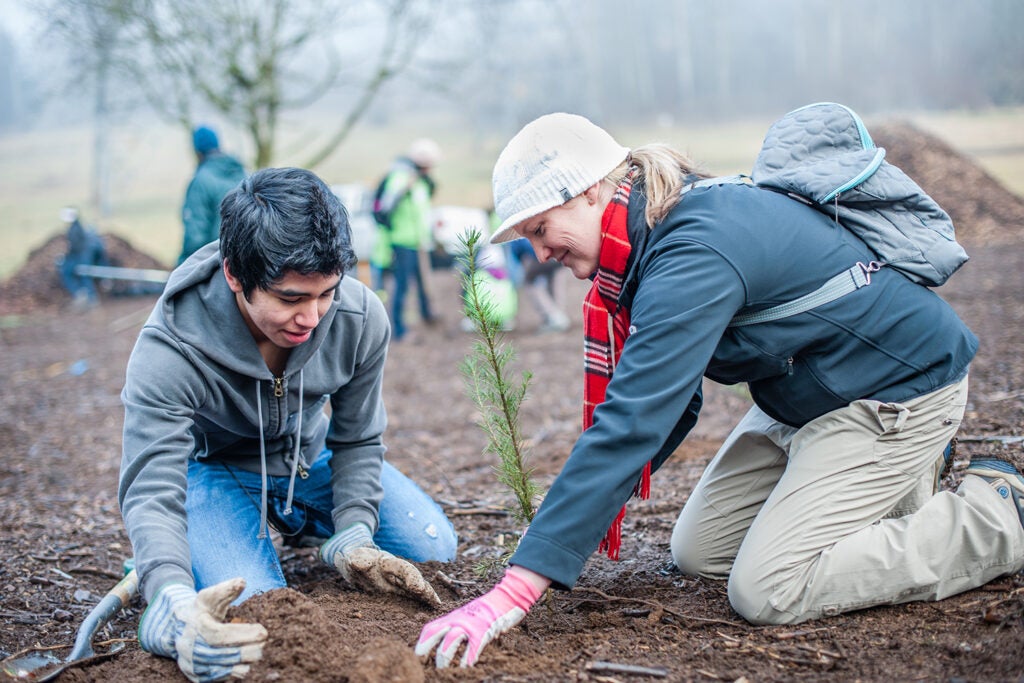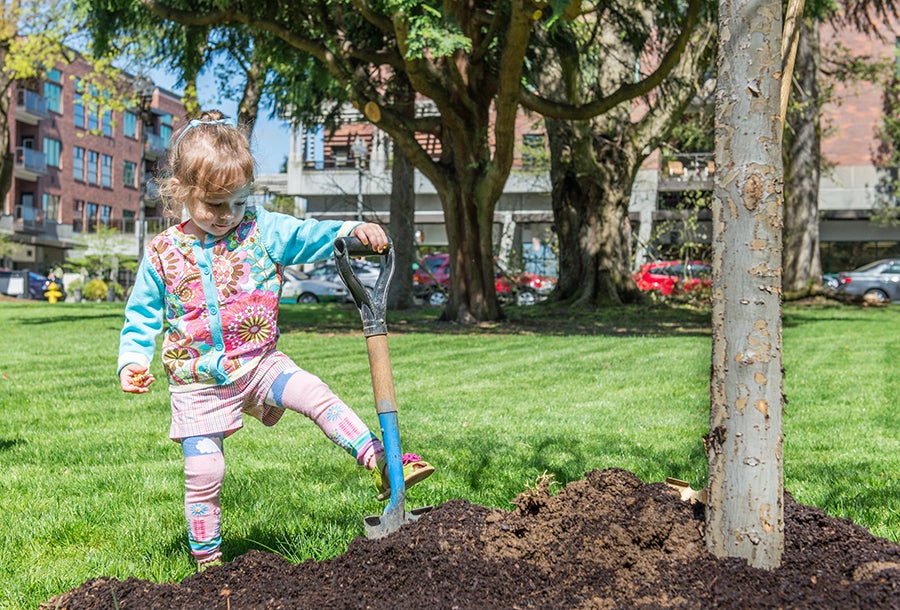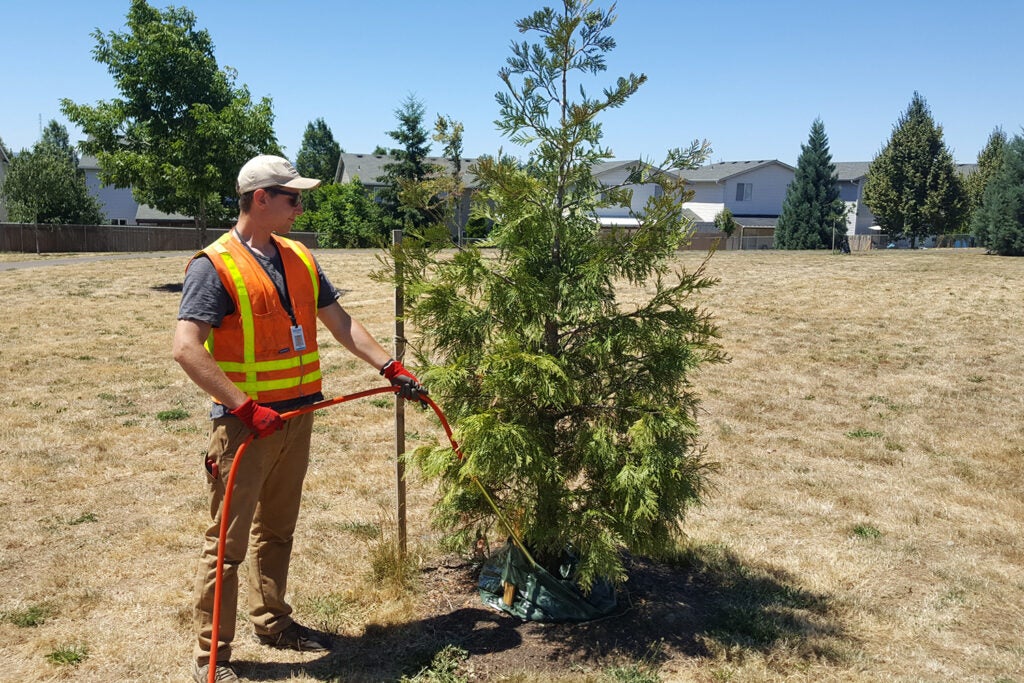Tree Planting and Establishment
Recognizing the numerous benefits trees provide, the city is making an investment in the future by caring for the trees we have and planting many more trees throughout the city. Vancouver Urban Forestry is partnering with neighborhoods, businesses, and property owners to increase tree canopy cover from 21 percent to the goal of 28 percent by 2047. This includes planting and caring for trees in parks, natural areas, and medians and supporting neighborhoods to organize neighborhood tree plantings and tree care events to reverse the canopy decline.

Find a Tree
A tree is a lifetime investment. For a healthy tree that will last into the future be sure to consider the type of tree you select, where you plant it and the care you provide over the years. Start with a new tree – there are several ways to plant a tree at a free or reduced cost at your home.
TreeFund Program
The city’s Treefund Program offers a rebate on City-approved trees planted on residential property within the City of Vancouver. Receive 50% off the cost of a tree, up to $50. Learn more by visiting the Treefund webpage or calling 360-487-8308.
Yard Tree Giveaway Program
Vancouver Urban Forestry distributes free yard trees through our Yard Tree Giveaway Program in the fall. Yard trees are trees planted on private, residential property in the City of Vancouver.
Friends of Trees
Friends of Trees, a local non-profit, provides City-approved trees for only $35, sometimes less. Even better, they dig the hole and help plant the tree as part of a community tree planting event. To get a tree for your home or to volunteer on planting day, visit friendsoftrees.org or email AdelaM@friendsoftrees.org.
Vancouver plantings
Urban Forestry partners with businesses, schools, community groups, property owners, and neighborhoods to plant trees throughout Vancouver. Learn more about the School Tree Planting program and get more trees at your school (see below). We may be able to help with the design, selection, and planting of trees. Call 360-487-8308 or send us an email for more information.
Tree Planting
In the Pacific Northwest, the ideal time to plant is during the fall and winter, when the trees are dormant.
Get involved: Interested in getting pruning or planting experience? Check out our events calendar or email us.

Choose the Right Tree
Select a tree species that is well-suited to your climate, soil type, and available space. Consider factors such as the tree’s mature size, growth rate, and environmental requirements.
Street trees (planted within 10 feet of the street) in the City of Vancouver require a free street tree planting permit to assist homeowners with proper placement and species selection.
Select the Planting Site
Choose a location that provides adequate sunlight, proper drainage, and enough space for the tree to grow without interference from buildings, utilities, or other plants.
Prepare the Planting Hole
Dig a hole that is two to three times wider than the tree’s root ball but only as deep as the root ball itself.
Loosen the soil in the planting hole to promote root penetration and growth.
Remove the Tree from its Container
Carefully remove the tree from its container, being mindful not to damage the roots. If the tree is root-bound (with roots circling around the root ball), gently tease out the roots to encourage outward growth.
Expose the root flare
Most trees are buried too deep in their containers. The root flare is where the trunk widens just above it’s first roots. Remove any soil or growing medium above this top root to ensure the base of your trunk looks like a traffic cone – not a telephone pole.
Plant the Tree
Planting depth is important. Don’t plant your tree too deep. Make sure the trunk flare remains visible.
Backfill the hole with soil, tamping it down gently to eliminate air pockets.
Water the tree thoroughly to settle the soil around the roots.
Proper Tree Planting Resources
The Arbor Day Foundation has resources on proper tree planting for the various types of trees you are planting, including bare root, container, or ball and burlap. Proper planting is critical to the trees health and longevity.
You can also watch the tree planting video made by Friends of Trees for some good tips to be sure you plant your tree correctly.

Tree Establishment
After planting, your tree will need establishment care such as weekly summer watering, mulching, and light maintenance in order to survive and thrive.
Mulch the root zone
Apply a layer of organic mulch, such as wood chips or shredded bark, around the base of the tree to conserve moisture, suppress weed growth, and regulate soil temperature.
DO NOT pile the mulch against the trunk ‘volcano-style’. Leave a small gap around the base of the trunk.
Water regularly
Most new trees need 15 gallons of water each week in the summertime. Best to fully soak the root zone 12 inches deep on weekly basis or twice per week.
Frequent shallow waterings with a spray irrigation system are not ideal and encourage shallow roots. Watch this tree watering video to learn more.
Monitor and maintain
Keep an eye on the tree for signs of stress, pests, or diseases, and take appropriate measures to address any issues that arise. Continue to provide care and maintenance as needed to support the tree’s growth and development.
Establishment period
Establishment period for new trees is 2-3 years after planting, depending on the site and species. Once established, trees generally have developed a healthy root system that can access water from deeper soil layers, making them more resilient to drought conditions. However, even established trees may still require occasional watering during periods of extended drought or extreme heat, especially if the soil becomes dry. Learn more about establishment care.

